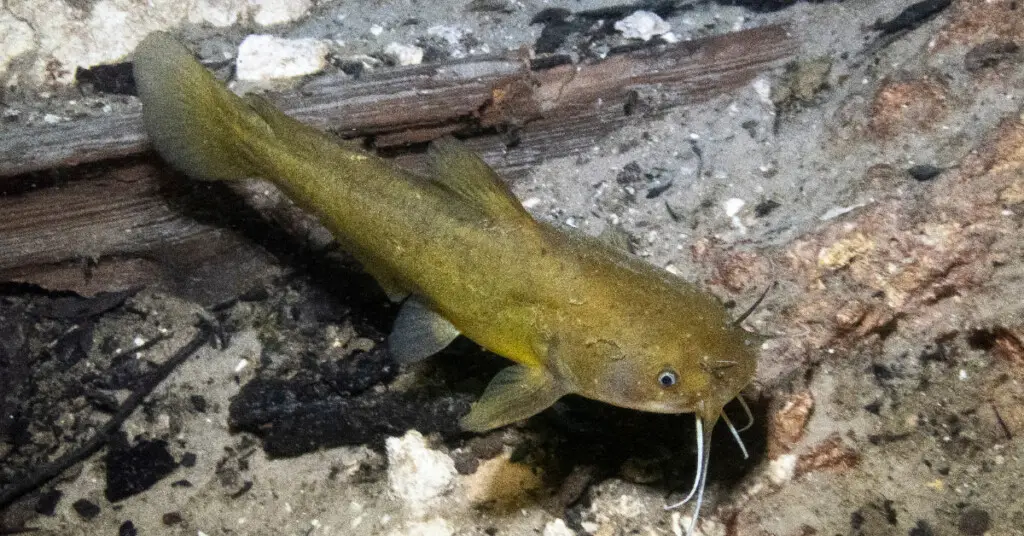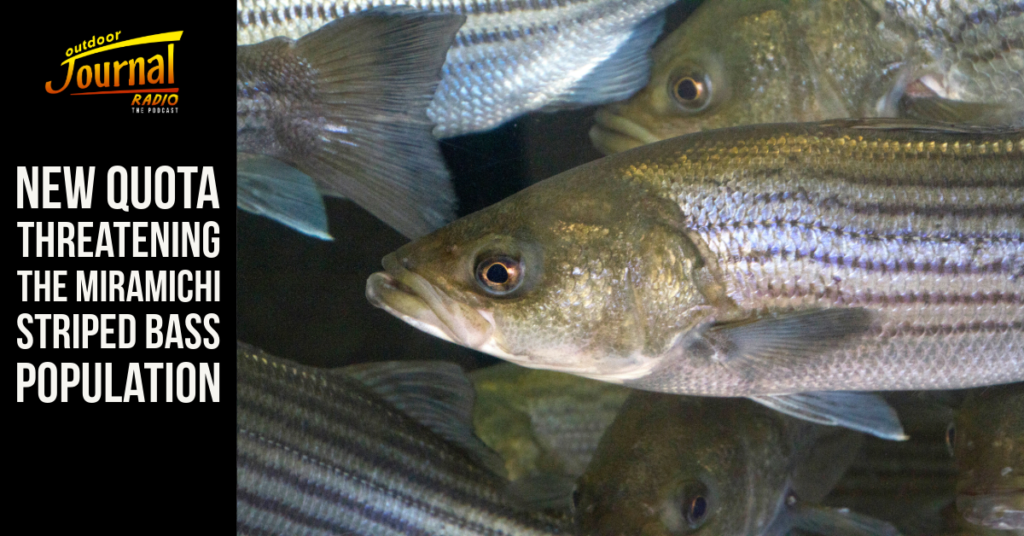During a research expedition earlier this year, an electroshocking boat generated a strong electric current in the waters of Lake Memphremagog, which straddles the border between Vermont and Quebec.
The electrical charge was just sufficient to temporarily immobilize the fish, causing them to float to the surface, upside down. Scientists then collected them using nets and transferred them to holding tanks.
Their primary focus was on brown bullhead, a whiskered species known for its preference to burrow in the lake’s sediment. The scientists aimed to examine the skin, organs, blood, and genetic makeup of these fish.

While collecting data back at the dock in Newport, Pete Emerson (left) holds up a brown bullhead with melanomas on the left, while a colleague holds up a healthy fish. Both were caught in Lake Memphremagog in May 2023.
Pete Emerson, Vermont’s Northeast Kingdom state fisheries biologist, and his team have made a startling discovery. They found that between 35% and 45% of mature brown bullhead in Lake Memphremagog suffer from melanoma, an exceptionally rare form of skin cancer in fish, particularly among bottom-dwelling species like these. Remarkably, this cancer prevalence rate has never been observed in fish anywhere else.
Approximately a decade ago, anglers began reporting the presence of fish with tumors. Initially, scientists suspected a viral infection in the bullhead population, but thus far, they haven’t identified a definitive cause.
While bullhead is cherished for its delectable taste in Vermont, scientists’ concerns about these fish extend beyond culinary preferences.

A scientist with Vermont Fish and Wildlife hooks up the anode of the electrofishing boat on Lake Memphremagog. The boat delivers a shot to the water, and stuns fish, making it easier to catch them for research.
Vicki Blazer, a fishery biologist affiliated with the U.S. Geological Survey, is collaborating with the University of Vermont and Vermont Fish and Wildlife to investigate the issue.
“Brown bullhead are a highly valuable indicator species, particularly in assessing sediment-related concerns. They have served as indicator species in the Great Lakes region for decades, so we possess extensive historical data on them,” Blazer explained.
Think of an indicator species as a kind of environmental thermometer for a lake’s overall health—a canary in a coalmine, if you will. By diagnosing the condition of these fish, researchers might uncover clues about pollutants affecting the ecosystem.

Scientists with the USGS and Vermont Fish and Wildlife net stunned brown bullhead in a cove on Lake Memphremagog.
Vicki has conducted extensive research involving bullhead in polluted harbors within the Great Lakes and Chesapeake Bay. However, she acknowledges that the findings from Memphremagog are unlike anything she’s encountered before.
To date, their investigations have included testing fish tissue for PFAS, colloquially known as “forever chemicals.” Blood plasma samples have also been subjected to examination.
Additionally, the researchers have screened for approximately 60 different chemical contaminants, including pesticides, PCBs, and heavy metals. They’ve also assessed the presence of polycyclic hydrocarbons, or PAHs, chemicals associated with gasoline and other fossil fuels and linked to fish cancers in the Great Lakes.
While most fish tested positive for PAHs, PCBs, and PFAS, the scientists assert that the concentrations are too low to pinpoint a single chemical as the sole cause. Furthermore, they have observed healthy fish with higher concentrations of both types of these chemicals in other lakes and rivers across Vermont.

The control panel on the electrofishing boat, where Pete Emerson with Vermont Fish and Wildlife controls the voltage put out into the lake.
Blazer is optimistic that genetic research might lead them to the solution:
“There are certain genes that will indicate what they’ve been exposed to,” Blazer said.
Genes have the capacity to be activated or deactivated like switches. Occasionally, a chemical pollutant or radiation can trigger this switch, as can a virus or a combination of factors.
To delve into this, it’s essential to have a comprehensive understanding of the genetic blueprint of a healthy individual. Remarkably, prior to this project, no one had ever mapped the genome of a brown bullhead.
Julie Dragon, a geneticist affiliated with the University of Vermont, is at the forefront of this research.
“We kind of liken it to a jigsaw puzzle, where you know, you’ve got the box as a reference, and you’re matching up pieces that you need,” Dragon said. “You need the picture from the box.”
Subsequently, Dragon and her research team will conduct a comparative analysis of the genetic profiles of brown bullhead with cancer and those of healthy fish. Their goal is to identify variations in the genetic makeup where differences exist.

A scientist moves a brown bullhead that has melanomas from a net and into the holding tank onboard the electrofishing vessel on Lake Memphremagog.
She explains that it’s akin to searching for a needle in a haystack. This process might be time-consuming, and it’s plausible that multiple genes or triggers may be involved.
“It will not be easy to answer this question,” Dragon said. “I would love to say that sequencing is the end-all be-all, but it’s not. I mean, it just gives us more to think about.”
However, certain individuals in the Northeast Kingdom argue that, irrespective of the cancer’s cause, there are immediate measures the state could implement to enhance water quality.
“I really insist that that is a really good reason not to ever deliberately or accidentally contaminate further the water of Lake Memphremagog,” said Peggy Stevens, an organizer with the grassroots environmental watchdog group Don’t Undermine Memphremagog’s Purity, or DUMP.
In Newport’s South Bay, there are several industrial sites that DUMP and others believe may be contributing to pollution, including an old railroad yard.

The landfill in Coventry.
Additionally, there’s the Coventry landfill, where state regulators have identified the presence of PFAS in the leachate, which used to be discharged into the lake.
Peggy highlights that, for certain chemicals, the EPA has essentially declared that even minimal exposure poses a risk to human health.
Although Peggy and DUMP do not directly attribute the bullhead cancer to the landfill, she views it as a cautionary signal that regulators should take more extensive measures to safeguard the lake.
“It’s just more about, let us, please, let’s protect the lake from further contamination,” Stevens said.
They also have concerns because the state hasn’t unequivocally stated whether it’s still safe to eat these delicious fish.
According to Pete Emerson from Fish and Wildlife, having access to the brown bullhead genome will be immensely beneficial for identifying issues in polluted lakes throughout the entire Northeast region. Additionally, it might provide scientists with more insights into how chemicals such as PFAS impact human tissues.
Emerson remains hopeful that the root cause of the problem is something that can be remedied.
“People love to eat these fish,” Emerson said. ” I’m really nervous that it might be something that we can’t solve.”
He hopes to have some answers in the next couple of years.








